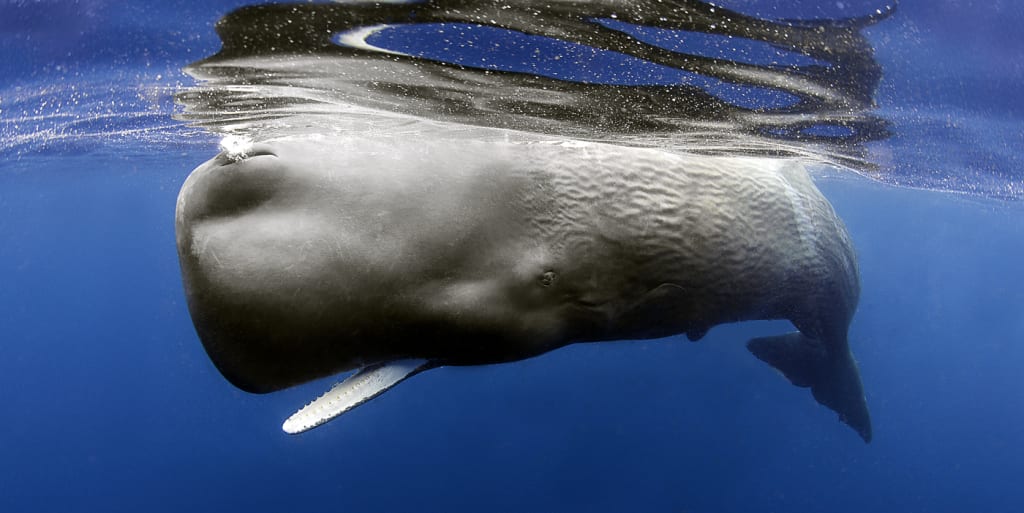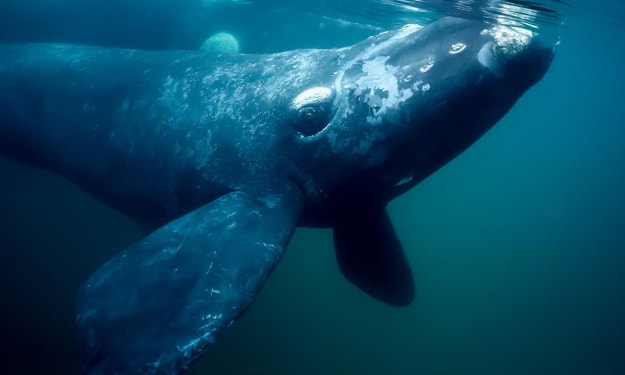Six Facts About the Sperm Whale
Meet the deep-sea marine mammal with the biggest mammalian brain on Earth.

The sperm whale (Physeter macrocephalus), made famous by Herman Melville’s Moby Dick, is the largest species of toothed whale in the world. At around 60 feet in length and weighing in at around 120,000 pounds, these predatory mammals are found throughout all of the world’s deep oceans and are regarded as one of the most extreme animals on the planets, due to being able to dive down to such great depths. So, here are some six facts about the sperm whale.
1. They have the biggest mammalian brains on Earth.
An adult sperm whale’s brain can weigh up to 18 pounds, which makes it five times the size of the size of a human brain. Although brain size has previously been used to measure intelligence in various animal species, more recent studies have confirmed that an animal species that has a larger brain size does not always equal high levels of intelligence. This means that we can’t measure the brain size of a sperm whale in order to determine any factor of high levels of animal intelligence. However, it has long been known that all cetacean species, including sperm whales, have been known to display high levels of intelligence.
2. They are deep divers.
Research has suggested that sperm whales can dive to depths of about 3,280 feet in search of large squid to feed on. They can also hold their breaths underwater for up to 2 hours while spending only 10 minutes rafting at the surface of the ocean. On average, a sperm whale can swim up to 12 knots.
3. They live in matriarchal societies.
Sperm whales are social animals that live in stable, long-term matriarchal pods. These pods can consist of a dozen adult female sperm whales, their female calves, and young male calves. The male calves will leave their family pods when they are around six years of age to join male bachelor pods while their sisters will remain with the pods for life. However, unlike killer whales, sperm whale pods don’t seem to exhibit signs of associating with blood-related relatives like siblings, cousins, aunts, and grandparents.
4. They have a very unique way of socializing with one another.
When sperm whales socialize with one another, they emit a series of codas. Codas are known to be a series of complex patterns of clicks that serve as a form of social recognition to distinguish a different family pod. In addition, sperm whale pods tend to share their own repertoire that is delineated to each socially segregated clan. These vocal clans are collections of units that share similar coda dialects that enable the animals to not only be able to associate with each other, but also spend time together for a very long period of time. This includes mothers and calves who spend the majority of time foraging and socializing, which usually takes place during the hours of the afternoon.
5. They all share a single grandmother.
In a genetic study done on the genetic diversity of sperm whale populations, the DNA samples of about 1,600 animals were collected from different parts of the world. As predicted, these individual animals had similar mitochondrial DNA from the same female ancestor who is thought to have lived in waters off the Pacific coast around 80,000 years ago during the Last Great Ice Age. In addition, it also gave researchers the idea to conclude that sperm whales may have once had a strong genetic diversity until that point. Because the current social structures restrict sperm whales to have the ability to differentiate and obtain new strains of DNA, it’s now believed that all sperm whale populations have long been shaped by female “homebodies.” This makes the species more prone to the effects of climate change.
6. They are loud enough to 'kill' you (or at least, your eardrums).
In recent years, scientists have begun to hypothesize that sperm whales can either stun or kill their prey by just simply using sound. In fact, the largest sound that was ever produced by a sperm whale was recorded by a single click that reached 235 decibels above the surface of the ocean. This is similar to sound pressures that are created by small rockets at the distance of a single meter.
Thank you so much for getting to know the sperm whale. If you liked this and other written works, feel free to send me a tip. If you would like to request for me to write a story on a wildlife-related topic that you think I should cover, contribute to my Patreon for as little as a dollar. Anyway, thank you for reading my work
About the Creator
Jenna Deedy
Zoo and Aquarium Professional, Educator, Cosplayer, Writer and B.A. in Psychology whose got a lot to share when it comes to animals, zoos, aquariums, conservation, and more.
Instagram: @jennacostadeedy






Comments
There are no comments for this story
Be the first to respond and start the conversation.